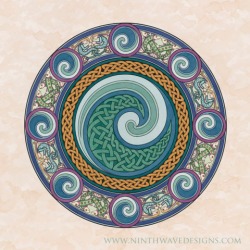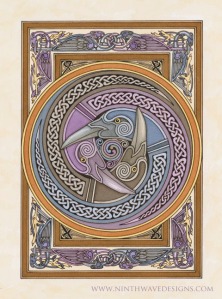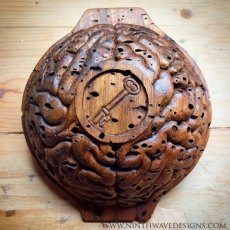 Lisa Laughy is a woodcarver and painter living in central New Hampshire. She has been carving for the last ten years after spending several decades as a designer and illustrator. Lisa’s work is primarily influenced by the early medieval Irish manuscript art best known by the Book of Kells, but other influences can be found in nature, the Stave Churches of Norway, Viking art, geometry and alchemical engravings.
Lisa Laughy is a woodcarver and painter living in central New Hampshire. She has been carving for the last ten years after spending several decades as a designer and illustrator. Lisa’s work is primarily influenced by the early medieval Irish manuscript art best known by the Book of Kells, but other influences can be found in nature, the Stave Churches of Norway, Viking art, geometry and alchemical engravings.
Your bio mentions that you work in two mediums. Can you tell me more about how you create your art?
I am a woodcarver with a strong background in design and painting. It wasn’t until my creative work became focused on wood carving that I realized how much of the design process for my 2D work is conceptualized in relief — the criteria I use when visualizing a painting or design begins naturally in my mind as an image in low relief. I feel as if the years of designing, drawing, and painting in 2D were actually spent in preparation for working in wood, even though that was never part of my original plan. It has been a slow, steady, and seamless transition in my creative process between the two mediums, and I feel that each supports the other.
 At what point in your life did you start thinking of yourself as an artist?
At what point in your life did you start thinking of yourself as an artist?
My two earliest memories are of birds singing (Chickadees), and drawing with pencils and crayons. I have a painting of a Robin I did when I was five years old, and my mother submitted it to a magazine — that made a big impression on my little self. As far as I can remember I have always thought of myself as an artist.
How would you describe your spirituality?
“The sole purpose of human existence is to kindle a light in the darkness of mere being.” – Carl Gustav Jung
 How does your spirituality find expression in your art?
How does your spirituality find expression in your art?
I experience my creative process as a search for meaning — which I think is how a lot of people would describe their spirituality – but I don’t consider myself to be a spiritual person. For me, meaning is best explored and understood through symbols and myths — so much of my creative process is spent attempting to communicate personal meaning using those elements.
How do you connect with divine flow when you are creating?
Coloring has become enormously popular, and many people are discovering the meditative qualities of coloring complex patterns, or doodling along the lines of Zentangles, and I think to a great extent, that is a similar process to the ‘flow’ I experience when I am absorbed in creating a design, or focused on a carving. It is a kind of timelessness, a side-step from the usual experience of physical time, and it is an enormously relaxing and regenerative process.
I read a lot — especially about history, mathematics, science, and psychology. I look at a wide range of artwork and art history books. I look at nature, and pattern, and color. I use those elements as a filter for the thoughts and whatever else is churning around inside my head, and try to find a way to project something outward that captures some sense of meaning for what is going on for me. As an example: I recently bought a small chunk of interesting wood — wormy butternut — I knew I wanted to make a carved bowl, but this wood was riddled with worm holes. So I thought — what is a bowl with holes? A sieve! And then I thought — yeah, my brain has been like a sieve lately, I can’t seem to remember anything. This led me to the idea of carving a bowl with holes with a brain-like texture on the outside, to represent the frustration I have been feeling about my poor memory skills.
 How do you decide which ideas to pursue?
How do you decide which ideas to pursue?
I keep lots of notebooks and sketchbooks to capture ideas as they come to me — sometimes I am just making a quick sketch, or writing down a quote, or a note to follow up on an idea. Other times I am doodling to see what comes out. There are always ideas that have more immediate appeal than others, that seem to need the most attention at the time, or are more compelling in one way or another, and these are the things I work on first. But I often go back to those rough sketches at a later date and expand or adapt them. I feel like creative ideas set their own priority — what doesn’t emerge initially as an overly compelling idea often becomes something worth pursuing at another time.
If you were going to teach your creative process to someone else, what would be one or two of the key things you would share?
I think a lot of people feel that there is a great deal of mystery about the creative process, but it is helpful to remember that the more time you spend working at something the better you get — you will definitely improve as you go along. A large part of creativity is based in skill, and this is something that can always be improved through practice and learning. The aspect of the creative process that is more elusive is the internal aspect — the most important part of working creatively is what you as an individual bring to the process you practice.
Thanks Lisa!
 Find out more about Lisa and her work at www.ninthwavedesigns.com.
Find out more about Lisa and her work at www.ninthwavedesigns.com.
Like her Facebook page: https://www.facebook.com/Ninth-Wave-Designs-170082379680586/
Follow Lisa on Instagram: https://instagram.com/ninthwavedesigns/
Purchase her work here: https://society6.com/ninthwavedesigns
If you would like to be a featured artist on Art as Worship, email me at vlowry (@) gmail.com. While I’m no longer recording new episodes for the Art as Worship radio show, I’ll continue to feature artists using their written words to describe the connection between their art and their spirituality. Access the Art as Worship radio interviews on Empower Radio. Listen to an encore presentation of an artist’s interview each Wednesday at 9am Eastern on Empower Radio. Like us on Facebook at Art as Worship, then share your art and comments. Namaste!


